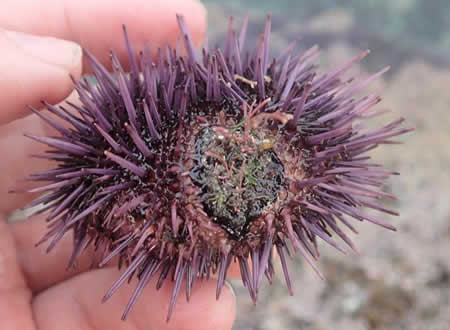A virus wiped out sea stars along the entire west coast last year. This year, an eerie new phenomenon, urchin balding, is attacking purple-spined sea urchins in Orange County tide pools, and local scientists are investigating this new mystery.

Photo By: Jayson Smith
Due to a warmer winter than usual, in and out of the ocean, tide pool conditions have worsened over the last year, said Jayson Smith, a Cal Poly Pomona marine biologist who specializes in the local tide pool habitat. Where once abalone, lobster and sea stars thrived, now sea hares, octopus, small fish, limpets and mussels seem to be leaving the scene, said Smith.
The latest debacle leaves urchins with bald spots, where algae takes root, said Jennifer Burnaford, biology professor at Cal State Fullerton.
The urchins are developing bare areas and, like scraggly new hair growth, algae is taking root in the soft tissue there, Burnaford said. “Coralline algae takes a long time to grow,” she informed tide-pool educators and docents during a workshop Saturday, May 2, at the Ocean Institute in Dana Point. “So it seems that the balding isn’t fatal.”
Scientists have yet to understand the urchin-balding syndrome, said Smith. Ocean advocates who recognize the problem have yet to take further protective steps to stop the declining conditions in the tide pools. “Things are looking pretty poor right now,” he commented. Educators and docents anecdotally report seeing fewer urchins at some tide pools and more empty shells.
The once-prolific California blue mussels are also becoming increasingly sparse along the Southern California coastline, Burnaford said.
In 2013, sea stars started dying en masse from Alaska to Mexico, causing what was described as the most pervasive marine mortality event in local waters, scientists reported. Last year, researchers released peer-reviewed papers identifying the cause as densovirus. The virus looked like leprosy with sea stars developing lesions, and then dropping limbs and losing entrails, often within hours.
Scientists continue to research why a virus, which sea stars contract periodically, wiped out the entire population. Possible causes that might have contributed to a compromised immune system, such as global warming, ocean acidification and pervasive water pollution, are still being studied.
Aside from the urchin and sea star issues, diversity in Orange County tide pools has been decreasing for decades, Smith said. There’s been a continual decline in the highly specialized animals that inhabit Laguna’s tide pools, added Louise Thornton, chair of Laguna Ocean Foundation, whose docents and staff provide tide-pool education and protection in Laguna Beach.
“We appear to have more than just the sea-star wasting,” Thornton said. “We appear to have something else going on. There’s something going on because the fish are disappearing.”
Keeping people’s hands out of the tide pools and away from the creatures can’t hurt, Smith and Thornton agreed. However, restricting public access to restore a declining habitat, even temporarily, runs counter to state public access laws regulated by the California Coastal Commission.
The Coastal Act strongly supports public access to California beaches and tidelands, and also requires that access is balanced with environmental concerns, said Sarah Christie, legislative director for the commission, headquartered in San Francisco. “If people are just saying, ‘Oh, we can’t do anything to protect the tide pools because the coastal commission’s public access policies won’t allow it,’ that’s not entirely accurate,” she said.
To place a temporary closure on local tide pools, a permit would be required “to verify that the public’s use of the tide pools is contributing to the degradation,” Christie said. “It’s not accurate to assume we wouldn’t allow it.” As an example, she noted that the commission imposed seasonal closures to protect snowy plover habitat.
Offering touch-tanks and traveling aquariums as alternatives to the tide pools are protective strategies used to lessen human impact on the tide pools, according to marine protection staff in Dana Point and Newport Beach.
Laguna Ocean Foundation unsuccessfully proposed a touch-tank at the new Laguna Beach lifeguard headquarters on Main Beach, and the foundation lacks the funding or a location for such a service now, said Thornton.
Dana Point uses a cart to show visitors shells, exoskeletons, skulls, teeth and other dry artifacts, said Sean Vogt, the city’s natural resources protection officer. “The idea is that visitors can touch, pick up and fully interact with these artifacts, while using more passive observation skills such as minimal handling in the tide pools so as to not disturb or injure the living creatures,” Vogt said.
Newport Beach uses a state-of-the-art truck, called the IsoPod, with two types of touch-tanks inside. The truck cost $160,000 in state grant money to customize and equip, said Michelle Clementine, Newport Beach marine protection officer. Visitors can interact with tide-pool animals in a controlled setting instead of touching them in their habitat, she said.
A student-study will begin this fall on whether touch-tanks keep people from poking, prodding, picking or poaching tide-pool animals, Smith said.





[…] the tide pools, she found about 20 still alive, fortunately sequestered in the rocky water […]
It’s Fukushima! Geez you idiots!
[…] Laguna Beach Independent, May 10, 2015 (emphasis added): Tide Pool Life Diminishes… an eerie new phenomenon, urchin balding, is attacking purple-spined sea urchins in Orange County tide pools, and local scientists are investigating this new mystery… tide pool conditions have worsened over the last year, said Jayson Smith, a Cal Poly Pomona marine biologist… Where once abalone, lobster and sea stars thrived, now sea hares, octopus, small fish, limpets and mussels seem to be leaving the scene, said Smith. The latest debacle leaves urchins with bald spots, where algae takes root, said Jennifer Burnaford, biology professor at Cal State Fullerton… Scientists have yet to understand the urchin-balding syndrome, said Smith… “Things are looking pretty poor right now,” he commented. Educators… report seeing fewer urchins at some tide pools and more empty shells. The once-prolific California blue mussels are also becoming increasingly sparse… “We appear to have more than just the sea-star wasting,” [Louise Thornton, chair of Laguna Ocean Foundation] said. “We appear to have something else going on. There’s something going on because the fish are disappearing.” […]
[…] Laguna Beach Independent, May 10, 2015 (emphasis added): Tide Pool Life Diminishes… aneerie new phenomenon, urchin balding, is attacking purple-spined sea urchins in Orange County tide pools, and local scientists are investigating this new mystery… tide pool conditions have worsened over the last year, said Jayson Smith, a Cal Poly Pomona marine biologist… Where once abalone, lobster and sea stars thrived, now sea hares, octopus, small fish, limpets and mussels seem to be leaving the scene, said Smith. The latest debacle leaves urchins with bald spots, where algae takes root, said Jennifer Burnaford, biology professor at Cal State Fullerton… Scientists have yet to understand the urchin-balding syndrome, said Smith… “Things are looking pretty poor right now,” he commented. Educators… report seeing fewer urchins at some tide pools and more empty shells. The once-prolific California blue musselsare also becoming increasingly sparse… “We appear to have more than just the sea-star wasting,” [Louise Thornton, chair of Laguna Ocean Foundation] said. “We appear to havesomething else going on. There’s something going on because the fish are disappearing.” […]
[…] This year, that’s not a problem, she said. The urchins started dying out earlier due to a “balding disease” and overpopulation has been curbed. “They’ve thinned out quite well,” said Caruso, who’s […]
Radiation from Fukushima!